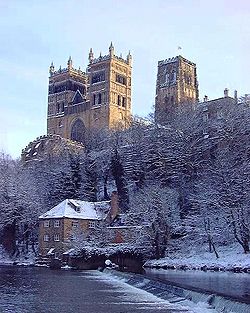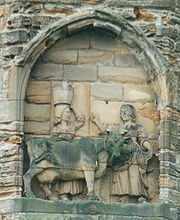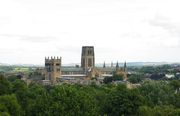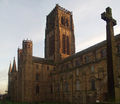Durham Cathedral
| Durham Cathedral | |

Durham Cathedral from across the River Wear |
|
| Basic information | |
|---|---|
| Full name | Cathedral Church of Christ, Blessed Mary the Virgin and St Cuthbert of Durham |
| Country | England |
| Ecclesiastical information | |
| Denomination | Church of England |
| Tradition | Broad Church |
| Province | York |
| Diocese | Durham |
| Diocese created | 995 (continuation of the see of Lindisfarne) |
| Dean | The Very Revd Michael Sadgrove |
| Precentor | The Revd Canon Dr David Kennedy |
| Canons | The Revd Canon Rosalind Brown The Revd Canon Dr Stephen Cherry The Ven Ian Jagger The Revd Canon Prof Mark McIntosh |
| Other chapter members | Philip Davies (Clerk) Dr David Hunt (Lay member) Adrian Beney (Lay member) |
| Director of Music |
Canon James Lancelot (Organist and Master of the Choristers) |
| Organist | Keith Wright (Sub Organist) |
| Website | www.durhamcathedral.co.uk |
| Building information | |
| Dates built | 1093-1133 |
| Architectural style | Romanesque |
| Length | 469 feet (143 m) (interior) |
| Width (nave) | 81 feet (25 m) (inc aisles) |
| Height (nave) | 73 feet (22 m) |
| Height (choir) | 74 feet (23 m) |
| Towers | 3 |
| Tower height(s) | 218 feet (66 m) (central tower) 144 feet (44 m) (western towers) |
The Cathedral Church of Christ, Blessed Mary the Virgin and St Cuthbert of Durham — known as Durham Cathedral — in the city of Durham, England, is the seat of the Anglican Bishop of Durham. The Bishopric dates from 995, with the present cathedral being founded in AD 1093. The cathedral is regarded as one of the finest examples of Norman architecture and has been designated a UNESCO World Heritage Site along with nearby Durham Castle, which faces it across Palace Green.
The present cathedral replaces the 10th century "White Church" built as part of a monastic foundation to house the shrine of Saint Cuthbert of Lindisfarne. The treasures of Durham Cathedral include relics of St Cuthbert, the head of St Oswald of Northumbria and the remains of the Venerable Bede.
Durham Cathedral occupies a strategic position on a promontory high above the River Wear. From 1080 until the 19th century the bishopric enjoyed the powers of a Bishop Palatine, having military as well as religious leadership and power. Durham Castle was built as the residence for the Bishop of Durham. The seat of the Bishop of Durham is the fourth most significant in the Church of England hierarchy, and he stands at the right hand of the monarch at coronations. Signposts for the modern day County Durham are somewhat fancifully subtitled "Land of the Prince Bishops."
There are daily Church of England services at the Cathedral, with the Durham Cathedral Choir singing daily except Mondays and while the choir is in recess. The cathedral is a major tourist attraction within the region, the central tower of 217 feet (66 m) giving views of Durham and the surrounding area.
Contents |
History
Saxon

The see of Durham takes its origins from the Diocese of Lindisfarne, founded by Saint Aidan at the behest of Oswald of Northumbria around AD 635. The see lasted until AD 664, at which point it was translated to York. The see was then reinstated at Lindisfarne in AD 678 by the Archbishop of Canterbury. The community at Lindisfarne Priory produced many saints, of which Saint Cuthbert who was Bishop of Lindisfarne from AD 685 until his death on Farne Island in 687 is central to the development of Durham Cathedral.
After repeated Viking raids, the monks fled Lindisfarne in AD 875, carrying St Cuthbert's relics with them. The diocese of Lindisfarne remained itinerant until 882, when a community was re-established in Chester-le-Street. The see had its seat here until AD 995, when further incursions once again caused the monks to move with the relics. According to local legend, the monks followed two milk maids who were searching for a dun (i.e. brown) cow and were led into a peninsula formed by a loop in the River Wear. At this point Cuthbert's coffin became immovable. This was taken as sign that the new shrine should be built here. A more prosaic set of reasons for the selection of the peninsula is its highly defensible position, and that a community established here would enjoy the protection of the Earl of Northumberland, as the bishop at this time, Aldhun, had strong family links with the earls. Nevertheless, the street leading from The Bailey past the Cathedral's eastern towers up to Palace Green is named Dun Cow Lane.
Initially, a very simple temporary structure was built from local timber to house the relics of Cuthbert. The shrine was then transferred to a sturdier, probably wooden, building known as the White Church. This church was itself replaced three years later in 998 by a stone building also known as the White Church and which was complete apart from its tower by 1018. Durham soon became a site of pilgrimage, encouraged by the growing cult of Saint Cuthbert. King Canute was one early pilgrim, granting many privileges and much land to the Durham community. The defendable position, flow of money from pilgrims and power embodied in the church at Durham ensured that a town formed around the cathedral, establishing the early core of the modern city.
Norman
The present cathedral was designed and built under William of St. Carilef (or William of Calais) who was appointed as the first prince-bishop by William the Conqueror in 1080.[1] Since that time, there have been major additions and reconstructions of some parts of the building, but the greater part of the structure remains true to the Norman design. Construction of the cathedral began in 1093 at the eastern end. The choir was completed by 1096 and work proceeded on the nave of which the walls were finished by 1128, and the high vault complete by 1135. The Chapter House, demolished in the 18th century, was built between 1133 and 1140.[2] William died in 1099 before the building's completion, passing responsibility to his successor Ranulf Flambard who also built Flamwell Bridge, the first crossing of the River Wear in the town. Three bishops William of St. Carilef, Ranulf Flambard, and Hugh de Puiset are all buried in the rebuilt Chapter House.
In the 1170s, Bishop Hugh de Puiset, after a false start at the eastern end where the subsidence and cracking prevented work from continuing, added the Galilee Chapel at the west end of the cathedral.[3] The five-aisled building occupies the position of a porch, it functioned as a Lady Chapel and the Great West Door was blocked during the Medieval period by an altar to the Virgin Mary. The door is now blocked by the tomb of Bishop Langley. The Galilee Chapel also holds the remains of the Venerable Bede. The main entrance to the cathedral is on the northern side, facing towards the Castle.
In 1228 Richard le Poore came from Salisbury where a new cathedral was being built in the Gothic style.[3] At this time, the eastern end of the cathedral was in urgent need of repair and the proposed eastern extension had failed. Richard le Poore employed the architect Richard Farnham to design an eastern terminal for the building in which many monks could say the Daily Office simultaneously. The resulting building was the Chapel of the Nine Altars. The towers also date from the early 13th century, but the central tower was damaged by lightning and replaced in two stages in the 15th century, the master masons being Thomas Barton and John Bell.[2]
The Shrine of St. Cuthbert was located in the eastern apsidal end of the cathedral. The location of the inner wall of the apse is marked on the pavement, and St. Cuthbert's tomb is covered by a simple slab. However, an unknown monk wrote in in 1593:
[The shrine] "was estimated to be one of the most sumptuous in all England, so great were the offerings and jewells bestowed upon it, and endless the miracles that were wrought at it, even in these last days."—Rites of Durham, [3]
Dissolution
Cuthbert's tomb was destroyed on the orders of Henry VIII in 1538,[1] and the monastery's wealth handed over to the king. The body of the saint was exhumed, and according to the Rites of Durham, was discovered to be uncorrupted. It was reburied under a plain stone slab, but the ancient paving around it remains intact, worn by the knees of pilgrims. Two years later, on December 31, 1540, the Benedictine monastery at Durham was dissolved, and the last prior of Durham -- Hugh Whitehead -- became the first dean of the cathedral's secular chapter.[3]
The Seventeenth Century
After the Battle of Dunbar, September 3, 1650, Durham Cathedral was used by Oliver Cromwell as a makeshift prison to hold Scottish prisoners-of-war. It is estimated that as many as 3,000 were imprisoned of whom 1,700 died in the cathedral itself, where they were kept in inhumane conditions, largely without food, water or heat. The prisoners destroyed much of the cathedral woodwork for firewood but Prior Castell's clock, which featured the Scottish thistle, was spared. The prisoners' bodies were buried in unmarked graves. The survivors were shipped as slave labour to North America.
In 1946 during work to install a new central heating system for the University, a mass grave of the Scottish soldiers was uncovered. In 1993 the Scottish Covenanter's Memorials Association discussed with the Cathedral the construction of a memorial to the soldiers, but this was inconclusive. Towards the end of 2007 a campaign was launched to commemorate the Dunbar Martyrs. Among the aims of the campaigners are to gain a Christian blessing for the dead and a memorial at the Cathedral burial site. Exhumation of the remains and reburial in Scotland is also under consideration.[4]
Bishop John Cosin, who had previously been a canon of the cathedral, set about restoring the damage and refurnishing the building with new stalls, the litany desk and the towering canopy over the font. An oak screen to carry the organ was added at this time to replace a stone screen pulled down in the 16th century. On the remains of the old refectory, the Dean, John Sudbury founded a library which contains early printed books.[3]
1700 - 1900
During the 18th century, the deans of Durham often held another position in the south of England, and after spending the statuatory time in residence, would depart to manage their affairs. Consequently, after Cosin's refurbishment, there was little by way of restoration or rebuilding.[3] When work commenced again on the building, it was of a most unsympathetic nature. In 1773 the architect George Nicholson, having completed the Prebend's Bridge across the Wear, persuaded the Dean and Chapter to let him smooth off much of the outer stonework of the cathedral, thereby considerably altering its character.[3]
The architect James Wyatt greatly added to the destruction by demolishing half the Chapter House, altering the stonework of the east end and inserting a very large rose window which was supposed to be faithful to one that had been there in the 13th century. Wyatt also planned to demolish the Galilee Chapel, but the Dean, John Cornwallis, returned and prevented it, just as the lead was being stripped from the roof.[3]
The restoration of the cathedral's tower between 1854 and 1859 was by the architect Sir George Gilbert Scott, working with Edward Robert Robson, who went on to serve as architect in charge of the cathedral for six years.[5] and a statue of William Van Mildert, the last prince-bishop (1826–1836) and driving force behind the foundation of Durham University.
20th century
| Durham Castle and Cathedral* | |
|---|---|
| UNESCO World Heritage Site | |
| State Party | |
| Type | Cultural |
| Criteria | ii, iv, vi |
| Reference | 370 |
| Region** | Europe and North America |
| Inscription history | |
| Inscription | 1986 (10th Session) |
| Extensions | 2008 |
| * Name as inscribed on World Heritage List. ** Region as classified by UNESCO. |
|
Today, the Cathedral remains the seat of the Bishop of Durham.
In 1986, the Cathedral, together with the nearby Castle, became a World Heritage Site. The UNESCO committee classified the Cathedral under criteria C (ii) (iv) (vi), reporting, "Durham Cathedral is the largest and most perfect monument of 'Norman' style architecture in England".[6]
In 1996 the Great Western Doorway was the setting for Bill Viola's large-scale video installation The Messenger.
Durham Cathedral has been featured in the Harry Potter films as Hogwarts School of Witchcraft and Wizardry, where it had a spire digitally added onto the top of the famous towers.
Interior views of the Cathedral were featured in the 1998 film Elizabeth.
21st century
Architectural historian Dan Cruickshank selected the Cathedral as one of his four choices for the 2002 BBC television documentary series Britain's Best Buildings.[7]
In November 2009 the Cathedral admitted female choristers for the first time.[8][9] Two weeks later the Cathedral featured in a son et lumière festival whose highlight was the illumination of the North Front of the Cathedral with a 15 minute presentation which told the story of Lindisfarne and the foundation of Cathedral, using illustrations and text from the Lindisfarne Gospels.[10]
Architecture

The building is notable for the ribbed vault of the nave roof, with pointed transverse arches supported on relatively slender composite piers alternated with massive drum columns, and flying buttresses or lateral abutments concealed within the triforium over the aisles. These features appear to be precursors of the Gothic architecture of Northern France a few decades later, doubtless due to the Norman stonemasons responsible, although the building is considered Romanesque overall. It was the skilled use of the pointed arch and ribbed vault which made it possible to cover far more elaborate and complicated ground plans than hitherto. The buttressing made it possible both to build taller buildings and to open up the intervening wall spaces to create larger windows.
Saint Cuthbert's tomb lies at the East in the Feretory and was once an elaborate monument of cream marble and gold. It remains a place of pilgrimage.
Organ and organists
Organ
Details of the organ from the National Pipe Organ Register
Organists
|
|
Assistant organists
- John Matthew Wilson Young, --?-- to 1850 (then organist of Lincoln Cathedral)
- Thomas Henry Collinson
- J.C. Whitehead, ? - 1874
- Revd John Lionel Shirley Dampier Bennett, 1895–1903
- F. E. Leatham, 1901 (temporary during absence of J. L. Bennett)
- William Ellis, 1903 - 1918 (afterwards organist of Newcastle Cathedral)
- Basil S. Maine, 1918-1919
- Cyril Beaumont Maude, 1919–1968
- Bruce Richard Cash, 1968–1972
- Alan Thurlow, 1973 - 1980 (later Organist Chichester Cathedral)
- David Hill, 1980–1982
- Ian Shaw, 1982–1985
- Keith Wright, 1991–present
See also the List of Organ Scholars at Durham Cathedral.
Quotations

"Durham is one of the great experiences of Europe to the eyes of those who appreciate architecture, and to the minds of those who understand architecture. The group of Cathedral, Castle, and Monastery on the rock can only be compared to Avignon and Prague." -- Sir Nikolaus Pevsner, The Buildings of England.
"I paused upon the bridge, and admired and wondered at the beauty and glory of this scene...it was grand, venerable, and sweet, all at once; I never saw so lovely and magnificent a scene, nor, being content with this, do I care to see a better." -- Nathaniel Hawthorne on Durham Cathedral, The English Notebooks.
'With the cathedral at Durham we reach the incomparable masterpiece of Romanesque architecture not only in England but anywhere. The moment of entering provides for an architectural experience never to be forgotten, one of the greatest England has to offer.' -- Alec Clifton-Taylor, 'English Towns' series on BBC television.
"I unhesitatingly gave Durham my vote for best cathedral on planet Earth." -- Bill Bryson, Notes from a Small Island.
- "Grey towers of Durham
- Yet well I love thy mixed and massive piles
- Half church of God, half castle 'gainst the Scot
- And long to roam those venerable aisles
- With records stored of deeds long since forgot."
-- Sir Walter Scott, Harold the Dauntless, a poem of Saxons and Vikings set in County Durham.[13]
More pictures
 Durham Cathedral from the south |
 Durham Cathedral and Castle |
 The Choir in 1890 |
 The Galilee Chapel in 1890 |
 West view from the Main Tower |
 View from St Margaret's churchyard |
 View from South Street |
 View from Prebends Bridge |
 The Cathedral Cloisters |
 The Cathedral at sunset |
 From Durham Students' Union |
 Cathedral at sunrise |
|
Durham Cathedral silhouetted against the sunset |
 Durham Cathedral from north west of the north door |
.jpg) The Rose Window in the Chapel of the Nine Altars |
 The Nave in 1890. |
 Durham Cathedral illuminated with images from the Lindisfarne Gospels for the Lumiere Festival 2009 |
See also
- Architecture of the medieval cathedrals of England
- English Gothic architecture
- Romanesque architecture
- Church of England
References
- ↑ 1.0 1.1 Tim Tatton-Brown and John Crook, The English Cathedral pp.26-29
- ↑ 2.0 2.1 John Harvey, English Cathedrals, p.129
- ↑ 3.0 3.1 3.2 3.3 3.4 3.5 3.6 3.7 Stranks, Durham Cathedral
- ↑ “The Dunbar Martyrs”
- ↑ Who Was Who, online edition, ROBSON, Edward Robert (subscription required), accessed 13 December 2008
- ↑ Full report (PDF file)
- ↑ Cruickshank, Dan. "Choosing Britain's Best Buildings". BBC History. http://www.bbc.co.uk/history/programmes/programme_archive/best_buildings_03.shtml. Retrieved June 3, 2008.
- ↑ "The Northern Echo: Durham Cathedral has female choristers at service". http://www.thenorthernecho.co.uk/news/4714377.History_made_as_girls_sing_at_cathedral/. Retrieved November 18, 2009.
- ↑ "Durham Cathedral - News - Here Come The girls". http://www.durhamcathedral.co.uk/introduction/news/160. Retrieved November 18, 2009.
- ↑ [1]
- ↑ Scholes, Percy A. (1970) The Oxford Companion to Music, 10th ed. London: Oxford U. P.; p. 468a (he destroyed some of his own anthems but those which survive are still sung)
- ↑ Scholes, Percy A. (1970) The Oxford Companion to Music, 10th ed. London: Oxford U. P.; p. 123b
- ↑ The verse is inscribed on a plaque on Prebends Bridge, which still affords the excellent view of the Cathedral which inspired it, sometimes known as Scott's View ("Scott's View". http://links.jstor.org/sici?sici=0020-2754(1982)2%3A7%3A3%3C354%3AVLIMTV%3E2.0.CO%3B2-N. and Walter Scott. "Harold the Dauntless". http://www.walterscott.lib.ed.ac.uk/works/poetry/harold.html.)
Bibliography
- Clifton-Taylor, Alec (1967) The Cathedrals of England. London: Thames and Hudson
- Dodds, Glen Lyndon (1996) Historic Sites of County Durham Albion Press
- Harvey, John (1963) English Cathedrals. London: Batsford
- Moorhouse, Geoffrey (2008) The Last Office: 1539 and the dissolution of a monastery. London: Weidenfeld & Nicolson
- Stranks, C. J. The Pictorial History of Durham Cathedral. London: Pitkin Pictorials
- Tatton-Brown, Tim (2002) The English Cathedral; text by Timothy Tatton-Brown; photography by John Crook. London: New Holland ISBN 1843301202
External links
- Durham Cathedral Website
- Gallery of photos
- A Tour of Durham Cathedral & Castle
- Webcam views: zoomed, wide angle
- Voted "Britain's Favourite Building" in BBC Radio 4 poll, 2001
- A history of Durham Cathedral
- A history of Durham Cathedral choristers and choir school
- Adrian Fletcher's Paradoxplace – Durham Cathedral Pages - Photos
- Place Evocation: The Galilee Chapel
- Local History Publications from County Durham Books
- Bell's Cathedrals: The Cathedral Church of Durham - from Project Gutenberg
|
|||||||||||||||||||
|
||||||||
